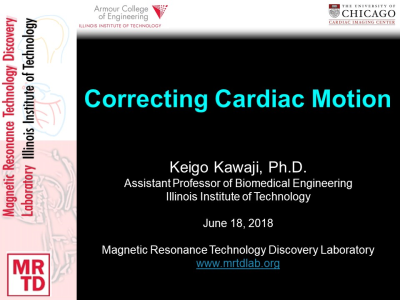|
Sunrise Session
Advanced Techniques in Cardiovascular MR: More Motion |
|
Advanced Techniques in Cardiovascular MR: More Motion
Sunrise Session
ORGANIZERS: Tim Leiner, Bernd Wintersperger
Monday, 18 June 2018
| S02 |
07:00 - 07:50 |
Moderators: Dana Peters, Walter Witschey |
Skill Level: Intermediate
Session Number: S-M-02
Overview
This course will review advanced techniques for characterizing myocardial tissue abnormalities and measuring function. The course will also overview rapid acquisition approaches for assessing cardiac disease as well as exploring multimodality strategies for imaging the heart.
Target Audience
Attendees who have intermediate to advanced knowledge of cardiac MR methodology and wish to learn about evolving approaches to assessing cardiac disease and become familiar with emerging imaging technologies.
Educational Objectives
As a result of attending this course, participants should be able to:
-Describe novel techniques for assessing cardiac function and evaluating myocardial function;
-Summarize rapid acquisition strategies for comprehensive MR assessment of the heart; and
-Explain multimodality approaches to assessing cardiac pathology.
07:00
|
|
Respiratory motion correction
Video Permission Withheld
Markus Henningsson
Respiratory motion remains a significant hurdle for widespread clinical adoption of CMR. This lecture will cover key concepts in respiratory motion correction, including respiratory navigators, gating, slice tracking, prospective/retrospective correction and the state-of-the-art in the field. The main focus will be on high-resolution volumetric coronary angiography, which has been an active area of research for 25 years, and the challenges of clinical translation. However, we will also discuss the unique challenges of motion correction for other applications such as quantitative CMR (T1 and T2 mapping) and late gadolinium enhancement.
|
07:25
|
 |
 Correcting Cardiac Motion Correcting Cardiac Motion
Keigo Kawaji
Early efforts towards the correction for cardiac motion have focused on addressing respiratory motion of the heart, and particularly for imaging of the coronary arteries. After over two decades of key developments that include navigator gating, self-navigation, and more elaborate 2D and 3D variants of these navigator approaches, numerous motion correction methods have proliferated to almost every aspects of cardiac MRI, including LGE, cine, relaxometry mapping approaches, tagging, perfusion, and new inherently 3D methods such as Quantitative Susceptibility Mapping. This presentation will additionally cover the current state-of-the-art methods that include highly advanced approaches in cardiovascular MRI research today.
|
07:50
|
|
Adjournment & Meet the Teachers |
|
| Back |
| The International Society for Magnetic Resonance in Medicine is accredited by the Accreditation Council for Continuing Medical Education to provide continuing medical education for physicians. |


